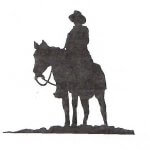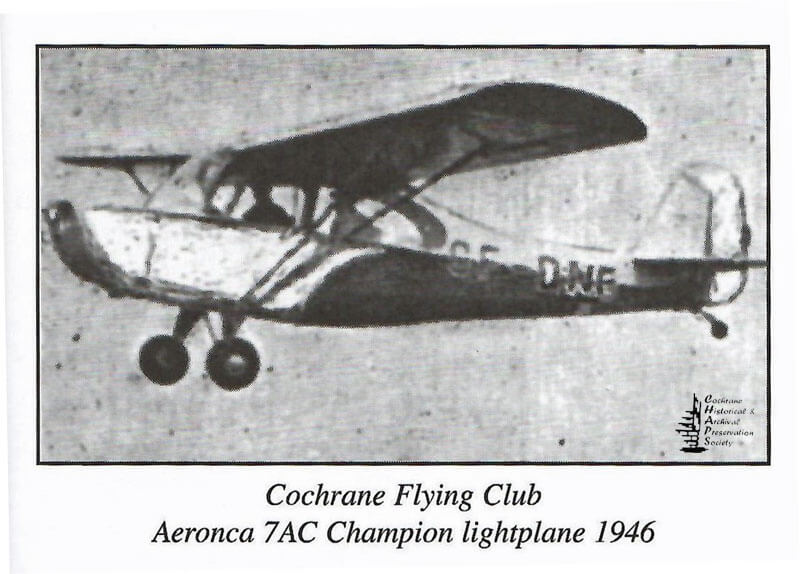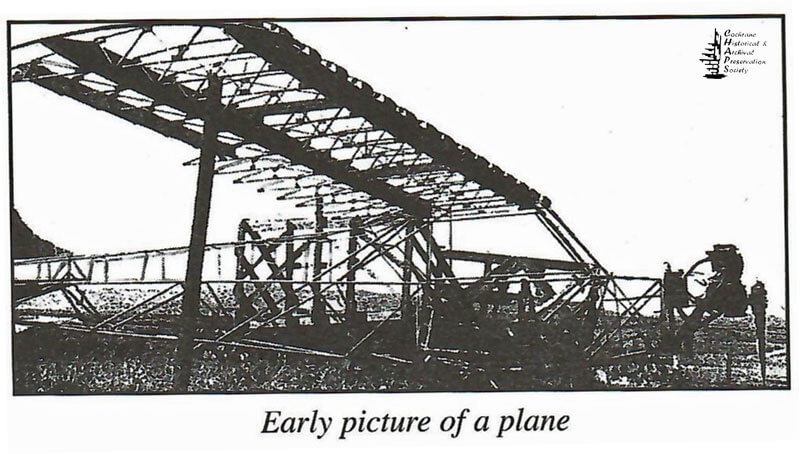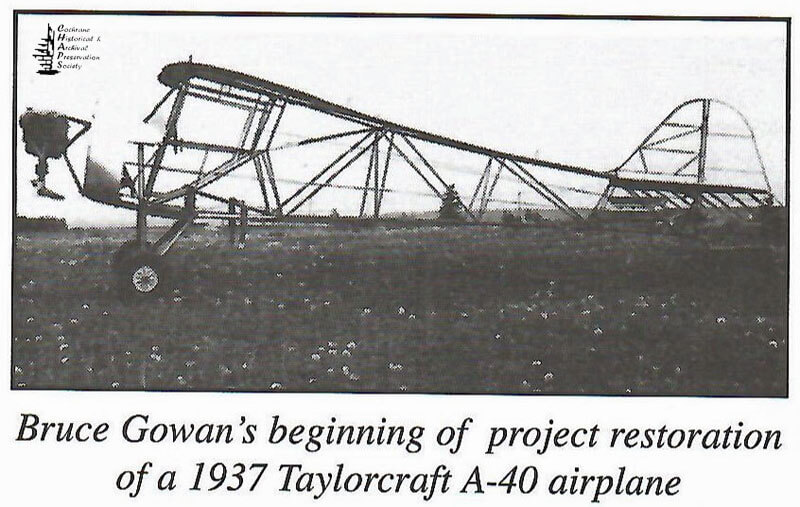pg 204 More Big Hill Country 2009
The twentieth century could be described as the era of mechanical transportation, a far cry from the open range.
The McDougall’s depended on the oxen to pull their Red River Carts to carry all their provisions on the trek westward from Fort Garry.
The early ranchers depended on their saddle horses to move and work their cattle on the open range.
In 1903, Henry Ford produced his first automobile and also on December 17, 1903, the Wright Brothers, Orville and Wilbur were the first men to fly in a heavier aircraft powered by an engine they designed.
Few urges have inspired and frustrated mankind as the desire to fly. The Wright brothers experienced this many times. In 1909, Louis Bleriot flew across the English Channel, and Charles Lindberg flew across the Atlantic from New York to Paris, France in 33 hours in the “Spirit of St Louis” Ryan monoplane. In 1929, the German Graf Zeppelin flew around the world in 21 days with four flight stops. Willy Post with Harold Gatty as navigator flew around the world from New York and back again in 8 days 16 hours. This route was across the Atlantic, Western Europe, Russia, Alaska, Canada, and the U.S.A. On July 22, 1933, he had flown around the world solo in 7 days, 18 hours, and 49 minutes with the aid of a radio compass directional finder. These were the early pathfinders of air transportation.
Gertrude de la Vergne, besides her love of horses, became interested in flying and in 1928 became the first licensed woman pilot in Alberta. Flying instruction was taken at the Calgary Aero Club in De Havilland Moths. Gertrude became involved with the R.C.A.F. Women’s Division at Number 5 E.F.T.S. High River, Alberta during WWII. She later married Reginald Tanner and moved to Vancouver B.C. Gertrude’s father, Charles de la Vergne’s family, was the successful owner of the de la Vergne Refrigeration Company of New York City. Mr. de la Verne bought 3 1/4 sections of land at Glenbow, a valley located north of the Bow River, west of Calgary in Township 25, Range 3, West of the 5th in 1909. He owned this property until 1933 when it was sold to Eric L. Harvie.
In 1953, Eric Harvie’s son Neil took over management of this Glenbow Ranch and in 1962 bought a used Piper Super Cub PA-18A CF-LQW which Neil used on the ranch. Neil’s son Tim still flies this airplane in 2006.
Barons Josef and Endre Csavossy, Hungarian noblemen bought 2 1/2 sections of the old Bow River Horse Ranch in 1925 on the south side of the Bow River in Township 25, directly across the river from the de la Vernes at Glenbow.
In 1928, besides winning a special award from the Agricultural Society for a fine outlay of farm buildings along the river flat, and a silver cup for a crop of oats on a plateau field east of the farm buildings, Baron Josef bought a Gypsy Moth aeroplane. After taking flying lessons from Freddie McCall, he became Alberta’s first flying farmer.
The Donald R. McLaurin farm and buildings, SW Sec 4 Twp 25 Range 3 W5M is 3 miles straight south of the Bow River Horse Ranch Buildings on the River flat. On January 22, 1969, the Department of Transport expropriated this farm and the Springbank Airport came into being. The majority of civil pilot training in the Calgary area is conducted at the Springbank Airport including helicopter training.
The Cochrane Flying Club was formed in the summer of 1946. Six members owned the Aeronca 7AC Champion lightplane with Canadian registration CF- DNF which Eustace Bowhay, in July 1946, ferried from the factory in Middleton, Ohio to the Chinook Flying Service in Calgary.
The Cochrane Flying Club president was Eustace Bowhay, Secretary was Bill Andison Jr. and Joe Mahood was Chief Instructor for the new fledgling club. Robby and Barbara Webb, Dallas Sperry from Cochrane, and Mile Martinusen and Victor Watson of Airdrie were some who took flying lessons from Joe. Mrs. Art and Mrs. Roy McPherson of Springbank were Joe Mahood’s sisters. He was born on a farm and grew up in Springbank. In the late 1930’s he moved to a farm of his own, north of Cochrane on the Bottrel Trail (highway 22). In 1940 Joe joined the R.C.A.F., first serving as a mechanic at Claresholm, Alberta. He then took training there and became an instructor on Ansons. In the last year, he served overseas with the Pathfinder Squadron, flying Mosquitoes. In 1948, Joe sold his farm and joined the staff of the Chinook Flying Service.
Bill Andison Jr. was born and grew up in Cochrane and later worked in his father’s grocery store on the main street. In the late 1950’s he moved to Victoria, B.C. Bill ferried two aircraft from Middleton, Ohio to the Calgary Chinook Flying Service. They were Aeronca 7DC, CF-FMN in April 1948 and Aeronca Chief, CF- FNO in June 1948. On the second trip, Joe Mahood flew him to Middleton from Calgary in CF-BTS, a Cessna T50 (Crane).
Eustace Bowhay grew up on a farm in Simons Valley, north of Calgary. He and his brother Lloyd lived there on a farm which their mother operated for many years. Eustace learned to fly after World War II in Calgary and became a partner with Franz McTavish of Chinook Flying Service as a flying instructor for a few years. Eustace married Nora Grisedale in 1946. Her parents lived on a farm in the Cochrane Lakes area.
Eustace and Nora built a restaurant “Bowhay’s Coffee Bar” north of the Cochrane Hotel and also a small house in the next adjoining lot. The restaurant building still stands today although somewhat modified. It was called the Range Grill for many years and now is Pix and Stix Music Headquarters. Their home was torn down to make room for the Rustic Market Square. Ernest and Mildred Thompson lived in this house from 1952 to the late 1960s, after they retired from their farm in the Glendale district.
Robby Webb was co-owner of Webb and Milligan Esso Service Station on the comer of 1st Street West and 1st Avenue W. They had the Ford car and farm tractor dealership. In 1969 it became Bow Ridge Motors and in 2000 was replaced with a new Royal Bank.
The Cochrane Flying Club field was located west of Highway 22 and south of 1A Highway and the C.P.R. line on land owned by John Boothby. It was a grass field, large enough to accommodate small twin-engined aircraft. A simple “T” shaped open front hanger was built to protect the Club plane from the weather. Fence posts for anchor support, walls, and roof sheeted in with shiplap boards. The open front was protected by a barbwire gate stretched across the front to keep Boothby’s cattle out when they were grazing in the field.
The Cochrane Flying Club plane successfully flew Mrs. Roy Buckler to the hospital when she became dangerously ill at her Bottrel farm home. Bill Andison Jr. responded to the call, in spite of a high wind and treacherous landing place at the farm. He successfully picked her up and flew to the Calgary Airport where an ambulance waited and took her to the hospital.
Angus MacKenzie experienced quite a few enjoyable flights with Bill Andison in the Flying Club Aeronca plane. One time, Angus and Dave Murray Jr. went with Bill to the flying field together. It was winter and the Club Airplane had its tires removed and was fitted with skis. Dave wouldn’t go flying because he said, “This engine is held on with only 4 bolts”, after looking at the open engine cowl when Bill was checking the oil level. Thus Angus got his first experience of flying with skis. The only regret Angus had was that he forgot to take the lens cover off his small camera, so there were no photos.
Dave Murray Jr. had built a hardware store a couple of years before, north of MacKay’s store on 2nd Ave. W. This store is now Westlands Art Gallery and Book Store.
As the only members left of the Club members in 1954, Bill Andison, Robby and Barbara Webb decided to sell the Club plane. Joe Mahood and Eustace Bowhay’s flying work took them to other parts of Canada. A rancher near Pincher Creek bought the Club plane.
In 1956 or 1957, Angus MacKenzie was visiting the Chinook Flying Services Calgary hanger workshop area and came across what looked like a totally stripped down fuselage of a red painted Aeronca Champ with cream trim. As the Cochrane Club plane had been painted red with cream trim in 1948.
Although thoroughly stripped down the color of the fuselage caught Angus’s attention and sure enough it was CF – DNF. It had been flown from Pincher Creek for a minor repair, but they forgot to tie it down while parked outside overnight. A strong chinook wind blew the plane over on its back and against a fence doing extensive damage to the wings and tail. It was now salvaged for parts. Who knows, maybe someone years later may have restored this plane as a building project. During the years 1958 to August 1961, Bill Perkins completely restored a 1936 Taylor J2 cub plane to flying shape. Most of this construction was done at their home on their Horse Creek farm. Bill’s rebuilt Taylor J-2 cub first flew in late August 1961 and it flew very well. Bill, an accomplished mechanic, had installed a Continental A-65 h.p. engine rather than the original Continental A-40 engine which gave a better performance at Cochrane’s higher altitude. Perkins used the Boothby field (the former Flying Club Field) but not the old hanger as it was too shabby. He just tied his airplane down outside, a short distance in front.
Due to some changes in the Taylor J-2 cub and a change of ownership of the company very few Taylor J-2 models appeared on the prairies during the hungry thirties. Chinook Flying Service of Calgary purchased one Taylor J-2 cub CF-AZK in 1946 for “cheap” student flying at Chinook.
Robert Martyn of Calgary built a sturdy all wood air- plane in his home in Calgary, a single seater of original design. Robert was a senior draftsman with Shell Oil. The first flight was May 14, 1960 at McCall Airport Calgary. After tests were done at Shephard airport, this home built plane was parked beside Bill Perkins Taylor J-2 cub for three years in the early 1960’s at the former Cochrane Flying Club Field of Boothby’s.
The Hang Gliders, as the new flying enthusiasts were called, are aircraft that fly without motors or any kind of external power. They use nature’s own forces of air and gravity aided by the energy the pilot contributes on take off in flight and landing. The Rogallo Kite depends entirely upon shifting the weight by the pilot for speed and direction.
In the 1970’s Willi Mueller bought property on the top of the Cochrane Hill and gave hang gliding flight instruction to students in the art of self kite flying. For the last 30 years Hang Gliding on the Cochrane Hill has been a common sight.
Aviation in Cochrane - Bruce Gowans By Angus MacKenzie
Bruce Gowans of Bearspaw did a complete restoration of a 1937 Taylorcraft A-40 airplane with Canadian registration CF-BGR in the 1970’s.
The last time this light airplane had flown was in 1941. C.G. Bradford from Pennsylvania is the designer of all the Taylor Cub and Piper Cub airplanes and also Taylorcraft Company in Alliance, Ohio, U.S.A.
Konnie Johannasson, Flying Service, Stevenson Airport, Winnipeg took delivery of CF-BGR in 1937 from the Taylorcraft Company and for the next three years, it was used mainly as a student trainer.
In August 1940 Spencer Addeman of Blackie, Alberta bought BGR and logged 116 hours on this airplane most of the time over the local countryside giving rides to family members and the occasional flight to Calgary.
In the spring of 1941, CF-BGR was sold to Lomer Cyr of Edmonton. This aircraft was due for an overhaul having 1230 hours of flying time logged. Lomer was told the Southern Alberta Institute of Technology (S.A.I.T.), Calgary would be the better shop during World War II for service for small civil airplanes so he flew BGR to Calgary and S.A.I.T. from Edmonton. It wasn’t until 1950 that Lomer Cyr inquired about BGR at S.A.I.T. and found nothing had been done on his plane due to a student shortage. He was advised that it would be cheaper for him to purchase one of the many surplus aircraft on the market at the time.
He decided to cancel the Department of Transport License on CF-BGR and the airplane remained at S.A.I.T. until 1960. It had been used for instructional purposes. It was then declared surplus.
The airplane was given to George Ryning who was an aircraft Maintenance Instructor and he had hoped to restore this airplane however was never able to find the time. In 1971, George Ryning turned CF-BGR over to Bruce Gowan as he had accepted a four-year posting in Zambia.
Bruce Gowan was also an instructor at S.A.I.T. but it wasn’t until 1977 that Bruce was able to start rebuilding BGR. Prior to this time, Bruce had spent a few years searching for original parts and pieces for this airplane and he actually succeeded in locating the original engine. In 1979, the wings were completely overhauled. Most of the restoration was done in Bruce’s garage at their home south of the Bearspaw Lifestyle Centre and Bearspaw School.
The completed Taylorcraft CF-BGR was test flown at Springbank Airport on June 18, 1980. After flight testing at Springbank Bruce’s airplane was flown to Airdrie Airport and tied down outside, close to his Cessna 170A airplane.
A severe hailstorm in the summer of 1987 did a lot of damage to the fabric-covered wings and tailplane of Bruce’s Taylorcraft so he decided to disassemble the airplane and put it into storage. Bruce still owns this aircraft today (2007). He sold his Cessna 170A a few years before and it is still in active flying service.






